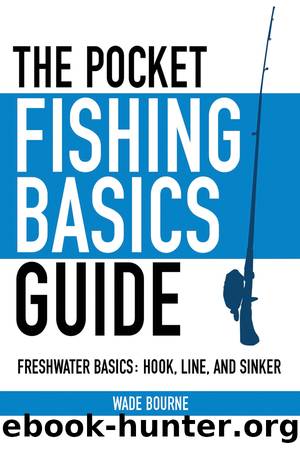The Pocket Fishing Basics Guide by Wade Bourne

Author:Wade Bourne [Bourne, Wade]
Language: eng
Format: epub
Publisher: Skyhorse Publishing, Inc.
Published: 2012-01-04T05:00:00+00:00
CrankbaitsâThis is another good lure family for beginners. Crankbaits are so-named because they have built-in actions. All you have to do is cast them and then crank the reel handle. The retrieve causes these baits to wiggle, dive and come to life.
Crankbaits are used mainly for largemouth and smallmouth bass, white bass, walleye, sauger, muskies and pike. They are effective in reservoirs, lakes and streams, around rocks, timber, docks, bridges, roadbeds and other structure. Generally they're not effective in vegetation, since their treble hooks foul in the weeds. However, crankbaits can be effective when retrieved close to weeds or over the top of submerged vegetation.
There are two sub-categories of crankbaits: âfloater/divers,â and âvibrating.â Floater/divers usually have plastic or metal lips. They float on the surface at rest, but when the retrieve starts, they dive underwater and wiggle back and forth. Usually, the larger a bait's lip, the deeper it will run.
One of the secrets to success with floater/divers is to keep them bumping bottom or cover objects. To do this, you must retrieve them so they will dive as deeply as possible. Maximum depth may be achieved by using smaller line (6â12 pound test is perfect), cranking at a medium pace instead of too fast, pointing your rod tip down toward the water during the retrieve and making long casts. Once the bait hits bottom, vary the retrieve speed or try stop-and-go reeling to trigger strikes. Keep it working along bottom as long as possible before it swims back up to the rod tip.
Sometimes a floater/diver crankbait gets âout-of-tuneâ and won't swim in a straight line. Instead, it veers off to one side or the other. To retune a lure, bend the eye (where you tie the line) in the direction opposite the way the lure is veering. Make small adjustments with a pair of needlenose pliers, and test the lure's track after each adjustment to get it swimming straight.
Vibrating crankbaits are used in relatively shallow water where fish are actively feeding. These are sinking baits, so the retrieve must be started shortly after they hit the water. They should be reeled fast to simulate baitfish fleeing from a predator. This speed and tight wiggling action excites larger fish into striking.
Soft PlasticsâThis family of baits includes plastic worms, grubs, minnows, tubes, lizards, craw-fish, eels, and other live bait imitations. These baits are natural-feeling and lifelike to fish. They are used mainly on bass, white bass, stripers, panfish, crappie, walleye and other species.
Download
This site does not store any files on its server. We only index and link to content provided by other sites. Please contact the content providers to delete copyright contents if any and email us, we'll remove relevant links or contents immediately.
Backpacker the Complete Guide to Backpacking by Backpacker Magazine(1814)
The Isle of Mull by Terry Marsh(1516)
Capital in the Twenty-First Century by Thomas Piketty(1418)
Predation ID Manual by Kurt Alt(1310)
The Collected Non-Fiction by George Orwell(1304)
Small-Bore Rifles by C. Rodney James(1270)
Creative Confidence by Tom Kelley(1140)
Backcountry Bear Basics by Dave Smith(1128)
All Fishermen Are Liars by John Gierach(1111)
50 Famous Firearms You've Got to Own by Rick Hacker(1101)
Blood Mountain by J.T. Warren(1089)
The Art of Throwing by Amante P. Marinas Sr(1076)
Archery: The Art of Repetition by Simon Needham(1065)
Long Distance Walking in Britain by Damian Hall(1050)
Backpacker Long Trails by Backpacker Magazine(1031)
The Fair Chase by Philip Dray(979)
The Ultimate Shooting Skills Manual: 212 Essential Range and Field Skills (Outdoor Life) by The Editors of Outdoor Life(963)
The Real Wolf by Ted B. Lyon & Will N. Graves(956)
The Ultimate Guide to Home Butchering by Monte Burch(948)
